Sri Lanka dazzles with its splendor and resilience

Peter Shelper – A view of Sigiriya, where a rogue king built a magnificent palace out of rock and extensive water gardens
SOURCE:–treehugger
The island that Marco Polo once described as “the most beautiful in the world” lived up to its reputation.
Exactly one year ago, I embarked on my first trip to Sri Lanka. Unfortunately it never happened because, while I was flying from Toronto to my connection in Abu Dhabi, three churches and three luxury hotels around Colombo were bombed, killing 259 people and injuring five hundred. It was Easter Sunday, April 21, 2019. Needless to say, the trip, which had been arranged by Intrepid Travel for a group of writers in honor of Sri Lanka being named top travel destination of the year by Lonely Planet, was called off.
Over the months that followed, I thought often of the trip that never was. I mourned on behalf of a country I’d not visited, but whose struggle to conquer adversity seemed never-ending. First, it had coped with a bloody thirty-year civil war, then the 2004 tsunami that ravaged the country, and now, just as life had seemed to settle down and the world’s attention (and tourist dollars) were shifting to this beautiful tropical island, another heartbreaking terrorist attack after ten years of calm.
Intrepid, being the ethically-minded tourism company it is, threw itself into maintaining relationships with local tour guides and, once the situation was deemed stable, encouraged visitors to come back. It reworked itineraries to take people to safer regions. I was delighted to get a second invitation, so I boarded a flight in December and landed without event in Colombo for a memorable 12-day tour of this island that had now reached near-mythical proportions in my mind.
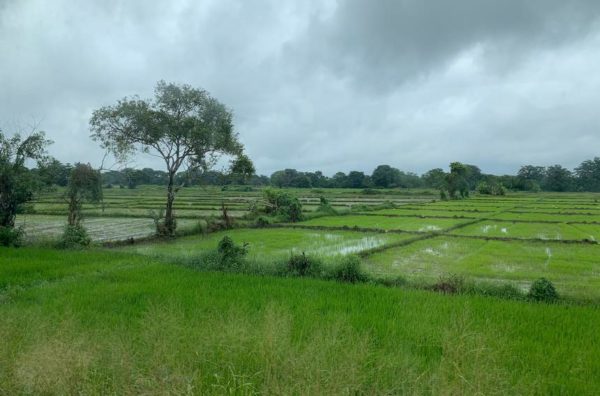
K Martinko – Rice paddies viewed from the train
Sri Lanka was fabulous. Lush and verdant, I’d never seen so much greenery before. The jungle pressed up against the narrow roads – coconut palms, banana trees, banyan trees, and other soaring varieties that my guide Ajith said were planted by the British to prevent the newly-poured asphalt from melting in the sun. There were colorful flowers and birds everywhere I looked, thriving in this hot, watery world. I was amazed to see peacocks in the wild, perched atop fence posts and flying low over rice paddies. Energetic monkeys were everywhere. The spice gardens, the white beaches and warm sea, the tea plantations, the dense low jungle where we went on safari in search of wild elephants (and found them!), the temples carved from rock and towering Buddha statues… the country impressed and dazzled in different ways every day.
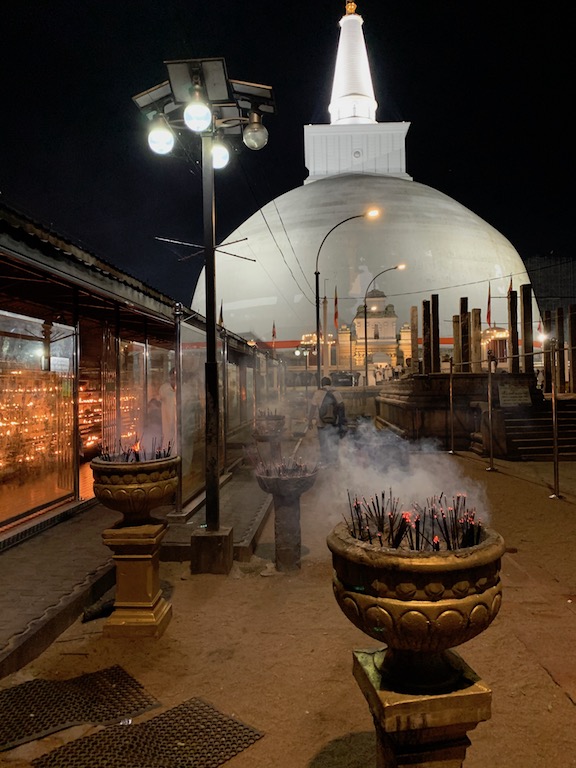
And the food! Where do I even begin? I’d read about string hoppers (little nests of steamed rice noodles), hoppers (thin crepe-like pancakes made from rice flour), coconut sambal (a spicy shredded fresh coconut condiment), dal, prawns, and lamprais (packets of rice and curry sealed up in a banana leaf). I feasted on this food three times a day, all washed down with cups of Sri Lankan tea and occasional chilled glasses of the nation’s favorite beer, Lion Lager.
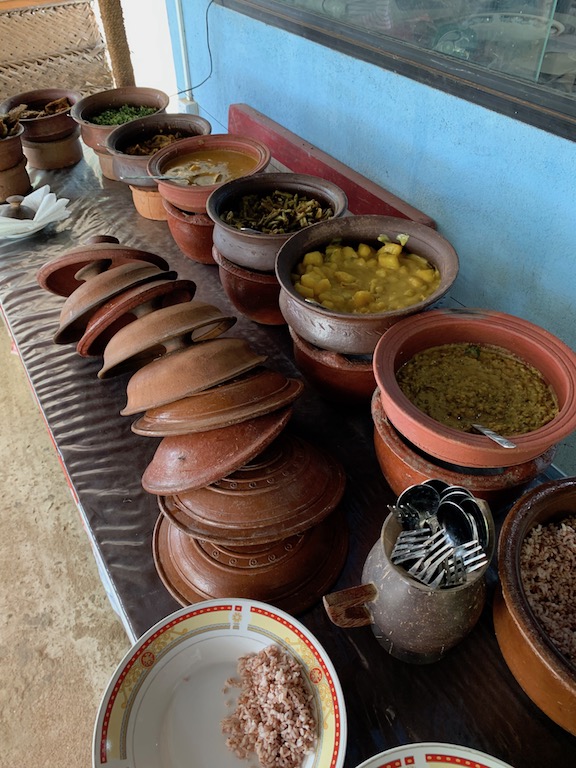
Lunch at a roadside stop between Negombo and Anuradhapura, Sri Lanka
This time, I’d been added to a regular tour, the Sri Lanka Explorer, so I found myself in the company of seven Australians (three couples and another solo traveller, like myself). We were a small group and got to know each other as the days went by. All were well-travelled individuals, older than I, and spoke highly of the company’s approach. One traveller, Gilda, who had done ten Intrepid tours, told me, “Some people call it lazy travel. I prefer to think of it as stress-free.”
Her description was accurate. As someone who has always organized my own trips, it was a radically new concept to relinquish control, to let local experts determine what I should see, to have all logistics arranged in advance. In that regard, it truly felt like a vacation. Nor did the schedule feel overly prescribed. There were enough empty hours and occasional free days to do some of my own exploring, and several meals that I foraged for myself at local restaurants or neighborhood grocery stores. I enjoyed the visits to local fruit and vegetable markets, the meals eaten at unassuming roadside stops and women-run food cooperatives, the spontaneous stops for samosas, ice cream, and tea whenever someone had a strong craving.
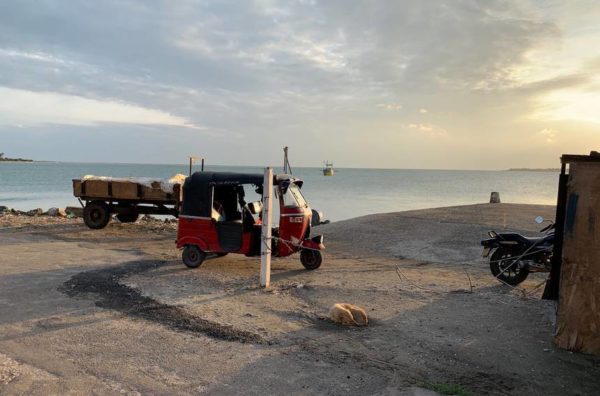
The many forms of transportation found in Sri Lanka
The itinerary was a mix of ancient historical sites, such as the ruins at Anuradhapura, one of the oldest continuously inhabited cities in the world and the birthplace of Sri Lankan Buddhism; geographical wonders, such as Sigiriya (“Lion Rock”) that towers an impressive 660 feet above the jungle, with palace ruins carved into the stone on top; and cultural activities, such as a visit to Negombo’s famous early-morning fish market and a cooking class taught in a family home in Kandy. I spent a day wandering the beach at Trincomalee, watched the sunset from the old Dutch Fort at Jaffna, and swam in a pool that claims to provide eternal youth and beauty. (Ironically, that’s where I discovered the first white hair on my head, so I think it backfired on me.) We travelled by public bus, train, boat, bicycle, on foot, and, mostly, in a small, comfortable private bus.

The pool of eternal youth and beauty, men’s section
Intrepid prides itself on hiring local tour guides and maintaining longstanding relationships with them. My guide, Ajith, has worked for Intrepid for 18 years, which means he’d started guiding tour groups even before the war ended. He was a kind, serious, and highly organized man, an expert at anticipating every question that could be asked and a walking encyclopedia of Sri Lankan history and lore. I learned he had a degree in archaeology, but had turned to tourism as a way to support his family. He was now the main breadwinner for his wife, three grown children, and adorable little granddaughter whose grinning face showed up on occasional FaceTime chats.
On the last night, over drinks in Colombo, Ajith told me about the tsunami and what it was like to wake up after Intrepid’s annual Christmas party and see the news on the TV. He said he tried frantically to call friends and contacts on the coast, but there was no answer. “They were gone,” he said. To think another similar scenario, albeit on a smaller scale, had played out less than nine months prior, made me feel even more grateful to be there, supporting the country in whatever small way I could.
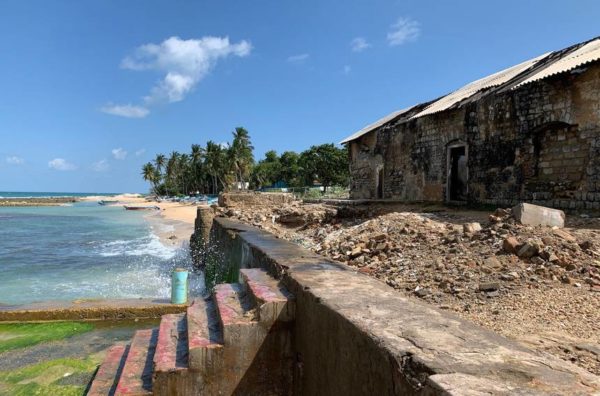
At Point Pedro, the northernmost tip of Sri Lanka, where a house was ruined by the 2004 tsunami
Ajith was committed to Intrepid’s progressive policies on animal welfare. We’d been told ahead of time that there would be no elephant rides or tickets to shows that use elephants in harmful ways, such has the annual Perahera Festival in Kandy. When we were at Sigiriya, a man with a flute and dancing cobra in a basket had attracted a crowd, but Ajith strode past without pausing. Once out of sight of the cobra trainer, he reminded us of Intrepid’s policy.
All the reading and writing I’ve done over the years about sustainable tourism has made me realize the power of foreign attention, and the fact that tourism initiatives will spring up wherever tourists are directing their attention. For example, if visitors like dancing snakes, there will be more dancing snakes. Personally, I do not want more dancing snakes, because they make me feel sad, just as I don’t want to see chained elephants giving rides or monkeys performing tricks, so I turn away when I see these things. We tourists have a responsibility to be conscientious observers, to stick to these beliefs, and to support others who share them.
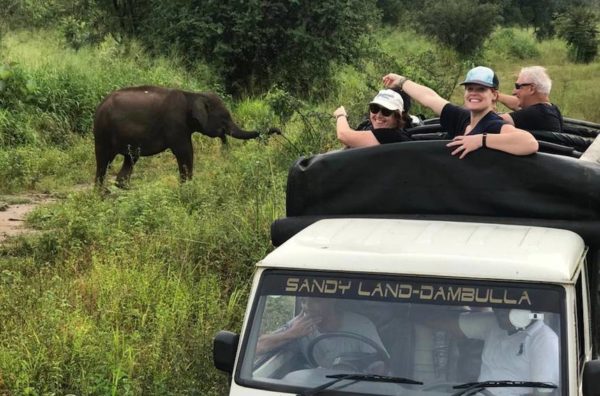
Elephant safaris within a designated wildlife preserve are considered acceptable, where wild animals are viewed from a distance.
Travel has always been a complex and fraught topic, from the early days of exploration, colonial expansion, and disease transmission, to the more recent questions of environmental degradation, local exploitation, and overtourism (although the question of disease transmission unfortunately persists in these days of COVID-19). But undeniable is the fact that travel is an innate instinct for many humans. The urge to see the broader world will drive certain individuals to move around the planet, whether others view it as a benefit or a detriment.
What I’ve concluded is that there are better and worse ways of doing it, and it’s up to us as responsible citizens of planet Earth to find those less-damaging ways and embrace them to the best of our ability. Slower travel is a key component of this and a noble goal; we should all be striving to reduce the number of trips we take and go for longer. But when that’s not possible, it feels good to support a company like Intrepid Travel that I believe is truly trying its best to make life better for everyone involved.
From its commitment to becoming climate positive and working toward gender equality (30 percent of tour guides are female and the company had hoped to double its number in 2020), to its B-Corp certification, dedication to working toward eight of the 17 United Nations Sustainable Development Goals where tourism can be applied, and millions of dollars of donations to grassroots organizations, Intrepid is a company taking its global responsibilities seriously.
I’d never been on a tour like this before. In fact, I’ll confess to being something of a travel snob that felt uninterested in travelling with a group of people and being tied to a schedule. Over the course of this trip, however, I realized that it’s not a bad thing to be part of a small group. It’s liberating not having to worry about the details, and it provided me access to distant, more obscure places that I wouldn’t have visited otherwise, such as Nanaitivu Island and Project Orange Elephant. Would I do it again? Yes, especially if I were visiting a place similar to Sri Lanka that is fairly rural, off the beaten track, and a bit tougher to navigate than, say, a European or South American destination. (Everyone will have a different perception of what’s easier and harder to navigate, but I feel an urge for guidance in Asia and Africa, both continents that fascinate and daunt me.)
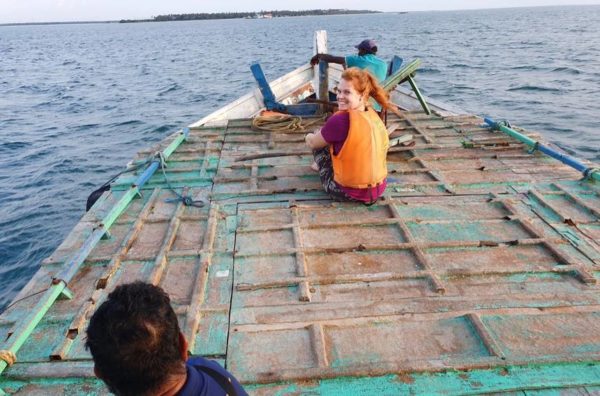
The author on the ferry to Nanaitivu Island
Right now the world is in a bizarre state of limbo. Most of us aren’t allowed to go anywhere for a while, so the world map on my wall, installed for the sake of my children’s sudden homeschooled education, is both a mild form of torment (“all the places Katherine can’t go right now!” my husband joked) and a doorway to the numerous travel memories squeezed into my mind and heart. I glance frequently at Sri Lanka, tucked in beside the southern tip of India. The divine taste of honey hoppers comes into my mouth and I think of Ajith and the many other people I met on that trip, wondering how they’re all doing in this most recent crisis, just when they emerged from the last one.
I feel some reassurance in knowing that Intrepid is looking out for them, that the company will be there once this is over, prepared to restart a sustainable tourism industry in a country that will likely need it more than ever. But in order for it to do that, it needs travellers who want to make a difference, too – people who realize that their travel dollars can be spent in ways that are positive and constructive for a country. So if you’re looking ahead, dreaming of all the places you’ll go, take a look at Intrepid’s website. Let them take you there, once the world reopens. You won’t be disappointed.








No Comments